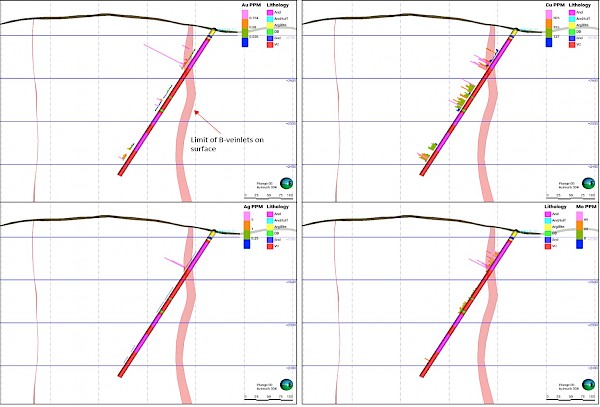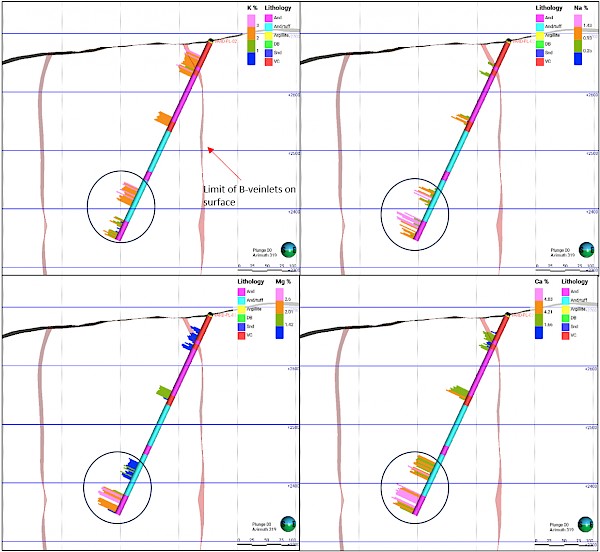Vancouver, British Columbia – March 1, 2024 – Fremont Gold Ltd. (TSXV: FRE; OTCQB: FRERF; FSE: FR2) (“Fremont” or the “Company”) is pleased to announce that encouraging historic drill data from the late 1950s pertaining to the Company’s Urasar property in Armenia has been identified. Additionally, results from the Company’s maiden drill program at the Vardenis project in central Armenia have been received.
Urasar project
Urasar was last worked by Soviet government teams in the 1950s and 1960s resulting in the identification of three mineralized zones and four geochemically anomalous zones along a 14 km strike length (see news release dated October 10, 2023).
At the end of 2023, the Company completed a soil geochemical survey comprising 744 C-horizon soil samples which display a continuous gold-copper/base metal anomaly over a 15 km strike length, as shown in the figure presented below. Gold values ranged up to 449 ppb with a mean of 142 ppb (see news release dated February 5, 2024).
Figure 1. Gold in C-horizon soil samples at Urasar
Recently recovered historic drill data
Fremont’s country manager and chief geologist, Hovhannes Karapetyan, recently uncovered in government archives, information regarding a historic Soviet drill hole from 1959, which is located within the western part of the Urasar exploration permit. Yellow River hole #1 (there were no subsequent Soviet drill holes in this zone) bottoms in 25 meters containing 1.27% copper from 209m to 234m vertical depth. Copper values higher up the hole were also anomalous ranging from below detection (300 ppm) to 0.77% Cu. Figure 2 shows the approximate location of this historic drill hole. This information is not compliant with NI-43-101 guidelines, and cannot be used for future resource calculations, but it does demonstrate the focus of previous exploration work and points to one of the main areas of follow-up for upcoming exploration work at Urasar. Once weather permits, the Company plans to rehabilitate the old road into the area, and carry out detailed mapping, additional sampling, and a ground magnetometer survey.
Figure 2. Location of historic drill hole at Vardenis
Vardenis project
The Razmik Cu-Mo porphyry target at Vardenis was the subject of two diamond drill holes totalling 770m in late October and early November 2023. The Razmik zone is likely the center of the entire 32 km2 Vardenis alteration system and is one of several significant and promising exploration targets within the property. The system is characterized by a large zone of quartz-sericite alteration with two centers of B and D-type porphyry-style veinlets*.
The quartz sericite alteration zone at Razmik measures approximately 2.1 km by 0.5 km with a NW strike and displays two centers of D and B veinlets, Razmik SE and Razmik NW. Razmik SE is approximately 450m by 300m of multiple outcropping zones of B veinlets surrounded by D veinlets. Sampling of these veinlets shows molybdenum values up to 600 ppm and copper values up to 0.14% Cu (historic Dundee Precious Metals Corp. data, hereafter referred to as“Dundee”, see news release dated June 6, 2023). Razmik NW comprises a core of B veinlets with dimensions of 430m by 230m, surrounded by a zone of pyrite veinlets of approximately 700m by 400m. Historical sampling shows molybdenum values up to 2,093 ppm (the highest Mo value in the property), and 442 ppm copper (also historic Dundee data). Figure 3 below displays Razmik NW, Razmik SE and the location of the two drill holes.
*Sillitoe, Richard H., Porphyry Copper Systems, Economic Geology, Volume 105, No 1, January 2010
Figure 3. VARD-01 and 02 drill hole locations at Vardenis; geochem data = surface rock chip values
Drill results
The visibly mineralized intervals from the two holes were submitted for fire assay and multi-element analysis comprising approximately half the drilled core. Both drill holes intersected geochemically anomalous gold and copper values, ranging up to 1.82 g/t Au in VARD-01 and up to 1,365 ppm Cu in VARD-02. The zones hosting significant sulfide mineralization that were processed from VARD-01 comprise 59m to 111m, 154m to 222m and 313m to 357m depth. From hole VARD-02, the zones sent for assay and multi-element analysis include the intervals 29m to 68m, 145m to 161m and 280m to 357m depth.
In total, 141 two-meter sample lengths were sent for geochemical analysis to the ALS laboratory in Romania. In addition, 39 samples were collected at 20m intervals from both holes for spectral short-wave infrared investigation which characterizes alteration assemblages used as vectors in copper porphyry exploration.
Figure 4. Au, Cu, Ag & Mo geochemical plots for VARD-01
Figure 5: Spectral data for VARD-01
Figure 6: VARD-02 - Strong anomalism of K, Na and Ca suggests alkali alteration such as destruction of Ca plagioclase to form K-feldspar or albite. This is a good indicator of higher temperature alteration processes at depth. High Mg anomalies at the bottom of hole may suggest chlorite or even biotite alteration. This K, Na and Mg increase is accompanied by a slight Cu anomaly.
Interpretation of drill results
VARD-01 and VARD-02 intersected anomalous gold and copper geochemistry, ubiquitous sericitic and argillic alteration, and significant porphyry-style quartz veining/brecciation (particularly in VARD-02), but did not penetrate to the potassic-altered, mineralized center of the system. Despite the lack of ore-grade values of copper and gold, these holes are the first step in the exploration of a large, mineralized porphyry system. Additional and deeper drilling will be necessary along with systematic sampling and spectral analysis of the existing and future drill holes. The important insights from this maiden drill program at Vardenis are the following:
- Significant copper and precious metal mineralization are typically absent in the transition zone from advanced argillic to mineralized potassic alteration environment. VARD-01 and VARD-02 were both drilled within this transition zone, but the depth and geometry of this transition zone are still to be determined;
- As shown in Figure 4, VARD-01 displays multiple geochemical anomalies high in the hole, near the surface limit of B-type veinlets. This coincides with a logged lithological contact and indicates the presence of a favourable hydrothermal feeder;
- This feeder/contact may conduit to high sulfidation mineralization associated with advanced argillic alteration and vuggy silica as occurs at high elevations at Vardenis --where Dundee drilled seven shallow holes exploring for gold (see TSX qualifying report, “Technical Geological Report for the Vardenis Property: Armenia, July 25, 2023, on the Company website);
- Spectral data from VARD-01 and VARD-02 show dominance of white mica with minor amounts of kaolinite, dickite, and chlorite, which reinforces the Company’s belief that the Razmik SE and Razmik NW zones are in the center of the copper porphyry environment;
- VARD-02 displays an encouraging trend of increasing copper towards the end of the hole as well as anomalous Na, Mg, Ca, with increasing quartz veining. These are good indications of increasing hydrothermal temperature and approaching mineralization;
- Additional detailed logging of both holes is necessary to verify vein classification, mapping of intrusive phases and review of alteration features.
President and CEO Dennis Moore commented, “The amount of porphyry-style veining, brecciation and sulfide mineralization observed in these two initial drill holes at Vardenis demonstrates that we are within the porphyry environment and just need to close in on the core of the mineralizing system. The limited spectral analysis completed to date indicates that we need to drill deeper. Additional detailed logging and analysis will be carried out by a porphyry copper specialist once the weather permits in late April or May.”
Moore continues, “To intersect significant intervals of economic mineralization in the first drill holes of an exploration campaign is an uncommon event that involves a bit of serendipity. The usual course of mine-finding is a deductional process involving stages of geophysics, detailed mapping, sampling, and of course additional drilling. We have just started, and we expect to be successful.”
Nevada gold assets
The Company has entered into an agreement to sell its wholly owned subsidiary, Intermont Exploration, Corp. (“Intermont”), to an Australian consortium (the “Buyer”). Intermont holds the Cobb Creek asset in Elko County Nevada. The purchase price totals US$300,000 to be paid over two years. Certain debts of Intermont owing to Fremont’s former Vice President of Exploration have been transferred to Fremont. The Buyer will assume all ongoing costs of Intermont including option and BLM payments. Other than Hurricane, Cobb Creek is the last remaining Nevada gold asset held by the Company. The Company continues to seek opportunities to monetise the Hurricane asset.
About Fremont Gold
Fremont’s mine-finding management team has assembled a portfolio of potential world-class copper-gold mineral opportunities within the central Tethyan belt of Armenia, and controls one gold exploration project located on the Cortez Trend in Lander County Nevada.
Qualified person
The content of this news release was reviewed by Dennis Moore, Fremont’s President, CEO and interim Chairman, a qualified person as defined by National Instrument 43-101.
On behalf of the Board of Directors,
Dennis Moore
President and CEO, interim Chairman
For further information, contact:
Telephone: +351 9250 62196
www.fremontgold.net
https://twitter.com/GoldFremont
https://www.linkedin.com/company/fremont-gold/
Neither TSX Venture Exchange nor its Regulation Services Provider (as that term is defined in the policies of the TSX Venture Exchange) accepts responsibility for the adequacy or accuracy of this release.
Forward looking statements
This news release contains forward-looking statements. All statements other than statements of historical fact included in this news release are forward-looking statements that involve risks and uncertainties. There can be no assurance that such statements will prove to be accurate and actual results and future events could differ materially from those anticipated in such statements including, without limitation, statements regarding future exploration programs at Urasar. Important factors that could cause actual results to differ materially from the Company's expectations including the risks detailed from time to time in the filings made by the Company with securities regulations. The reader is cautioned not to place undue reliance on any forward-looking information. Forward-looking statements contained in this news release are expressly qualified by this cautionary statement. The forward-looking statements contained in this news release are made as of the date of this news release and the Company will update or revise publicly any of the included forward-looking statements only as expressly required by Canadian securities law.








